TSR Action and Genesis Mechanism of Antimony Deposit: Evidence from Aromatic Hydrocarbon Geochemistry of Bitumen from Paleo-Oil Reservoir in Qinglong Ore Field, Southwestern Guizhou Depression, China
Abstract
1. Introduction
2. Geological Background
2.1. Regional Geology
2.2. Deposit Geology
3. Features of Qinglong Paleo-Oil Reservoir
4. Samples and Experimental Methods
5. Results
6. Discussion
6.1. Maturity and Source Rock of Paleo-Oil Reservoir Bitumen
6.1.1. Maturity
6.1.2. Organic Matter Source and Source Rock
6.2. Indication of the TSR Reaction
6.3. Genetic Relationship between Paleo-Oil Reservoir and Antimony Deposits
6.3.1. Spatial-Temporal Relationship between Hydrocarbon Accumulation and Antimony Mineralization
6.3.2. The Role of Paleo-Oil Reservoir in Antimony Mineralization
7. Conclusions
Author Contributions
Funding
Data Availability Statement
Acknowledgments
Conflicts of Interest
References
- Liu, C. Dynamics of sedimentary basin and basin reservoir (ore) forming system. J. Earth Sci. Environ. 2008, 1, 1–23, (In Chinese with English Abstract). [Google Scholar]
- Fuchs, S.; Schumann, D.; Martin, R.F.; Couillard, M. The extensive hydrocarbon-mediated fixation of hydrothermal gold in the Witwatersrand Basin, South Africa. Ore Geol. Rev. 2021, 138, 104313. [Google Scholar] [CrossRef]
- Pons, M.J.; Franchini, M.; Rainoldi, A.L.; Giusiano, A.; Cesaretti, N.N.; Montagna, A.O.; Herrington, R. Base metal mobility linked to brine and hydrocarbon migration at the Huincul High in the Neuquén Basin, Argentina: Implications for the formation of sediment-hosted base metal deposits. J. Geochem. Explor. 2021, 226, 106778. [Google Scholar] [CrossRef]
- Boreham, C.J.; Sohn, J.H.; Cox, N.; Williams, J.; Hong, Z.; Kendrick, M.A. Hydrogen and hydrocarbons associated with the Neoarchean Frog’s Leg Gold Camp, Yilgarn Craton, Western Australia. Chem. Geol. 2021, 575, 120098. [Google Scholar] [CrossRef]
- Vinnichenko, G.; Hope, J.M.; Jarrett, A.J.; Williams, N.; Brocks, J.J. Reassessment of thermal preservation of organic matter in the Paleoproterozoic McArthur River (HYC) Zn-Pb ore deposit, Australia. Ore Geol. Rev. 2021, 133, 104129. [Google Scholar] [CrossRef]
- Ge, X.; Selby, D.; Liu, J.; Chen, Y.; Cheng, G.; Shen, C. Genetic relationship between hydrocarbon system evolution and Carlin-type gold mineralization: Insights from Re-Os pyrobitumen and pyrite geochronology in the Nanpanjiang Basin, South China. Chem. Geol. 2021, 559, 119953. [Google Scholar] [CrossRef]
- Wang, G.; Huang, Z.; Zhao, F.; Li, N.; Fu, Y. The relationship between hydrocarbon accumulation and Mississippi Valley-type Pb-Zn mineralization of the Mayuan metallogenic belt, the northern Yangtze block, SW China: Evidence from ore geology and Rb-Sr isotopic dating. Resour. Geol. 2020, 70, 188–203. [Google Scholar] [CrossRef]
- Chi, G.; Xue, C.; Sun, X.; Lai, J.; Luo, P.; Song, H.; Li, S.; Zeng, R. Formation of a giant Zn–Pb deposit from hot brines injecting into a shallow oil–gas reservoir in sandstones, Jinding, southwestern China. Terra Nova 2017, 29, 312–320. [Google Scholar] [CrossRef]
- Gu, X.X.; Li, B.H.; Dong, S.Y.; Xue, C.J.; Fu, S.H. Hydrocarbon- and ore-bearing basinal fluids: A possible link between gold mineralization and hydrocarbon accumulation in the Youjiang basin, South China. Miner. Depos. 2012, 47, 663–682. [Google Scholar] [CrossRef]
- Wu, Y.; Zhang, C.; Mao, J.; Ouyang, H.; Sun, J. The genetic relationship between hydrocarbon systems and Mississippi Valley-type Zn–Pb deposits along the SW margin of Sichuan Basin, China. Int. Geol. Rev. 2013, 55, 941–957. [Google Scholar] [CrossRef]
- Hulen, J.B.; Collister, J.W. The oil-bearing, carlin-type gold deposits of Yankee Basin, Alligator Ridge District, Nevada. Econ. Geol. 1999, 94, 1029–1049. [Google Scholar] [CrossRef]
- Fallara, F.; Savard, M.M. A structural, petrographic, and geochemical study of the Jubilee Zn-Pb deposit, Nova Scotia, Canada, and a new metallogenic model. Econ. Geol. 1998, 93, 757–778. [Google Scholar] [CrossRef]
- Gu, X.; Zhang, Y.; Li, B.; Xue, C.; Dong, S.; Fu, S.; Cheng, W.; Liu, L.; Wu, C. The coupling relationship between metallization and hydrocarbon accumulation in sedimentary basins. Earth Sci. Front. 2010, 17, 89–111, (In Chinese with English Abstract). [Google Scholar]
- Hu, Y.; Ren, T. Metal deposits, oil and gas reservoirs: Two brothers in sedimentary basin. Chin. J. Nat. 2019, 41, 48–52, (In Chinese with English Abstract). [Google Scholar]
- Liu, J.; Ye, J.; Liu, J.; Tan, J.; Niu, J. Oil accumulation and ore-formation. Bull. Mineral. Petrol. Geochem. 2000, 3, 164–171, (In Chinese with English Abstract). [Google Scholar]
- Li, R.; Mao, J.; Zhao, B.; Chen, B.; Liu, S. A review of the role of hydrocarbon fluid in the ore formation of the MVT Pb-Zn deposit. Adv. Earth Sci. 2021, 36, 335–345, (In Chinese with English Abstract). [Google Scholar]
- Tu, G. The relationship between coal, oil, gas, salt and metal ore formation. Geol. Explor. Non-Ferrous Met. 1994, 3, 1–3. (In Chinese) [Google Scholar]
- Chen, G.; Xu, G.; Wang, T.; Ma, L.; Shi, L.; Zheng, C. The relationship between hydrocarbon accumulation and metallization and a discussion on intergrated exploration. Earth Sci. Front. 2008, 2, 200–206, (In Chinese with English Abstract). [Google Scholar]
- Luo, K.; Zhou, J.; Feng, Y.; Uysal, I.T.; Nguyen, A.; Zhao, J.; Zhang, J. In situ U-Pb Dating of calcite from the South China antimony metallogenic belt. iScience 2020, 23, 101575. [Google Scholar] [CrossRef]
- Ding, J.; Zhang, Y.; Ma, Y.; Wang, Y.; Zhang, J.; Zhang, T. Metallogenic characteristics and resource potential of antimony in China. J. Geochem. Explor. 2021, 230, 106834. [Google Scholar] [CrossRef]
- Yan, J.; Fu, S.; Liu, S.; Wei, L.; Wang, T. Giant Sb metallogenic belt in South China: A product of Late Mesozoic flat-slab subduction of paleo-Pacific plate. Ore Geol. Rev. 2022, 142, 104697. [Google Scholar] [CrossRef]
- Chen, J.; Huang, Z.; Yang, R.; Du, L.; Liao, M. Gold and antimony metallogenic relations and ore-forming process of Qinglong Sb (Au) deposit in Youjiang basin, SW China: Sulfide trace elements and sulfur isotopes. Geosci. Front. 2021, 12, 605–623. [Google Scholar] [CrossRef]
- Chen, J.; Yang, R.; Du, L.; Gao, J.; Zheng, L.; Huang, Z. Multistage fluid sources and evolution of Qinglong Sb-(Au) deposit in northern margin of Youjiang basin, SW China: REE geochemistry and Sr-H-O isotopes of ore-related jasperoid, quartz and fluorite. Ore Geol. Rev. 2020, 127, 103851. [Google Scholar] [CrossRef]
- Wang, D.; Qin, Y.; Wang, C.; Chen, Y.; Gao, L. Mineralization pedigree for epithermal Hg, Sb, Au deposits in Guizhou Province—Taking the Dachang Sb deposit, the Zimudang Au deposit and the Luanyantang Hg deposit for examples. Geotecton. Metallog. 2012, 36, 20–26, (In Chinese with English Abstract). [Google Scholar]
- Hu, Y.; Zhao, Y.; Liu, L.; Wang, J.; Li, W. Study on metallogenic coupling of compound half-graben and basin fluid in the Qinglong antimony deposit. Geotecton. Metallog. 2014, 38, 802–812, (In Chinese with English Abstract). [Google Scholar]
- Su, W.; Zhu, L.; Ge, X.; Shen, N.; Zhang, X.; Hu, R. Infrared microthermometry of fluid inclusions in stibnite from the Dachang antimony deposit, Guizhou. Acta Petrol. Sin. 2015, 4, 14–20, (In Chinese with English Abstract). [Google Scholar]
- Chen, J.; Yang, R.; Du, L.; Zheng, L.; Gao, J.; Lai, C.; Wei, H.; Yuan, M. Mineralogy, geochemistry and fluid inclusions of the Qinglong Sb-(Au) deposit, Youjiang basin (Guizhou, SW China). Ore Geol. Rev. 2018, 92, 1–18. [Google Scholar] [CrossRef]
- Chen, Y.; Liu, X.; Zhang, Q. A tentative discussion on the genesis of the Dachang antimony deposit, Qinglong county, Guizhou province. Miner. Depos. 1984, 3, 1–12, (In Chinese with English Abstract). [Google Scholar]
- Peng, J.; Hu, R.; Jiang, G. Samarium-Neodymium isotope system of fluorites from the Qinglong antimony deposit, Guizhou Province: Constraints on the mineralizing age and ore-forming materials’ sources. Acta Petrol. Sin. 2003, 19, 785–791, (In Chinese with English Abstract). [Google Scholar]
- Zhu, J.; Fang, W.; Liu, J.; Hu, Y. The REE characteristics and genetic study of Qinglong antimony deposit, Guizhou. Contrib. Geol. Miner. Resour. Res. 2010, 2, 118–123, (In Chinese with English Abstract). [Google Scholar]
- Xiong, C.; Liu, J.; Liu, S.; Wang, D.; Yang, C.; Wang, Z.; Chen, R. Study on fluid inclusion of Qinglong Dachang antimony deposit. J. Guizhou Univ. Nat. Sci. Ed. 2013, 30, 47–52, (In Chinese with English Abstract). [Google Scholar]
- Chen, X.; Su, W.; Huang, Y. He and Ar isotope geochemistry of ore-forming fluids for the Qinglong Sb deposit in Guizhou Province, China. Acta Petrol. Sin. 2016, 32, 76–84, (In Chinese with English Abstract). [Google Scholar]
- Pan, J.; Wu, D. Comparison of sources for the ore-forming fluids and materials for the antimony ore deposits in South and Southwest of Guizhou Province, China. Geol. Sci. Technol. Inf. 2017, 36, 123–132, (In Chinese with English Abstract). [Google Scholar]
- Wang, H.; Yi, J. The relationship between the organic matter and the antimony mineralization in Dachang district, Guizhou. Bull. Mineral. Petrol. Geochem. 1996, 15, 84–87, (In Chinese with English Abstract). [Google Scholar]
- Ye, Z.; Yi, J.; Hu, R. Organic matter and its role in mineralization in Dachang antimony deposit, Guizhou, China. Acta Mineral. Sin. 1997, 17, 310–315, (In Chinese with English Abstract). [Google Scholar]
- Liu, L.; Hu, Y.; Zhang, G. Raman spectral characteristics of Qinglong antimony ore field paleo-oil reservoir bitumen and hydrocarbon inclusions. Geol. Rev. 2016, 62, 1010–1020, (In Chinese with English Abstract). [Google Scholar]
- Wang, P.; Hu, Y.; Liu, L.; Zhang, G. Geochemical characteristics and genesis of bitumen in paleo-oil reservoir in Qinglong antimony deposit, Guizhou. J. Xi’an Shiyou Univ. Nat. Sci. Ed. 2016, 31, 44–49, (In Chinese with English Abstract). [Google Scholar]
- Cheng, Y.; Hu, Y.; Wang, D.; Wang, P.; Li, P.; Wang, X. Oil-source rock analysis and metallogenic significance of the palaeo-oil reservoir in the Qinglong antimony deposit, South China. Ore Geol. Rev. 2021, 137, 104281. [Google Scholar] [CrossRef]
- Wang, P.; Hu, Y.; Liu, L.; Jiang, X.; Li, C.; Bartholomew, C.J.; Zhang, G. Re-Os dating of bitumen from paleo-oil reservoir in the Qinglong antimony deposit, Guizhou Province, China and its geological significance. Acta Geol. Sin. 2017, 91, 2153–2163. [Google Scholar] [CrossRef]
- Wang, P.; Hu, Y.; Liu, L.; Zhang, G. REE geochemical characteristics and significance for bitumen in paleo-oil reservoir in Qinglong antimony deposit, Guizhou Province, China. Acta Mineral. Sin. 2017, 37, 106–113, (In Chinese with English Abstract). [Google Scholar]
- Hu, Y.; Liu, W.; Zhang, G.; Guan, S.; Lu, Y.; Li, P.; Zheng, S.; Fan, H.; Betts, P.G. Seismic reflection profiles reveal the ore-controlling structures of Carlin-style gold deposits in Lannigou gold fields, Southwestern Guizhou, China. Econ. Geol. 2022, 117, 1203–1224. [Google Scholar] [CrossRef]
- Hu, Y.; Liu, W.; Wang, J.; Zhang, G.; Zhou, Z.; Han, R. Basin-scale structure control of Carlin-style gold deposits in central Southwestern Guizhou, China: Insights from seismic reflection profiles and gravity data. Ore Geol. Rev. 2017, 91, 444–462. [Google Scholar] [CrossRef]
- Zhang, S.; Huang, H.; Su, J.; Liu, M.; Wang, X.; Hu, J. Geochemistry of Paleozoic marine petroleum from the Tarim Basin, NW China: Part 5. Effect of maturation, TSR and mixing on the occurrence and distribution of alkyldibenzothiophenes. Org. Geochem. 2015, 86, 5–18. [Google Scholar] [CrossRef]
- Wei, Z.; Walters, C.C.; Michael Moldowan, J.; Mankiewicz, P.J.; Pottorf, R.J.; Xiao, Y.; Maze, W.; Nguyen, P.T.; Madincea, M.E.; Phan, N.T.; et al. Thiadiamondoids as proxies for the extent of thermochemical sulfate reduction. Org. Geochem. 2012, 44, 53–70. [Google Scholar] [CrossRef]
- Hu, R.; Fu, S.; Huang, Y.; Zhou, M.; Fu, S.; Zhao, C.; Wang, Y.; Bi, X.; Xiao, J. The giant South China Mesozoic low-temperature metallogenic domain: Reviews and a new geodynamic model. J. Asian Earth Sci. 2017, 137, 9–34. [Google Scholar] [CrossRef]
- Hu, Y. Sedimentary Basin Analysis and Study on Antimony and Gold Mineralization in Southwest Guizhou Depression. Ph.D. Thesis, Kunming University of Science and Technology, Kunming, China, 2011. (In Chinese with English Abstract). [Google Scholar]
- Gao, W.; Hu, R.; Mei, L.; Bi, X.; Fu, S.; Huang, M.; Yan, J.; Li, J. Monitoring the evolution of sulfur isotope and metal concentrations across gold-bearing pyrite of Carlin-type gold deposits in the Youjiang Basin, SW China. Ore Geol. Rev. 2022, 147, 104990. [Google Scholar] [CrossRef]
- Tang, Y.; Zhen, L.; Li, Y.; Gao, X.; Zong, W.; Sun, Q.; He, D. The aromatic fraction of source rocks from the Jurassic Haifanggou Formation in Niuyingzi Depression of Lingyuan-Ningcheng Basin. Nat. Gas Geosci. 2019, 30, 433–446, (In Chinese with English Abstract). [Google Scholar]
- Radke, M.; Welte, D.H.; Willsch, H. Geochemical study on a well in the Western Canada Basin: Relation of the aromatic distribution pattern to maturity of organic matter. Geochim. Cosmochim. Acta 1982, 46, 1–10. [Google Scholar] [CrossRef]
- Radke, M.; Rullkötter, J.; Vriend, S. Distribution of naphthalenes in crude oils from the Java Sea: Source and maturation effects. Geochim. Cosmochim. Acta 1994, 58, 3675–3689. [Google Scholar] [CrossRef]
- Chen, Z.; Li, S.; Wang, Z. A study on maturity indicators some of some aromatics in low-midmature thermal evolution zones. Acta Sedimentol. Sin. 1997, 2, 192–197, (In Chinese with English Abstract). [Google Scholar]
- Chen, Z.; Zhang, J.; Niu, L.; Gao, Y.; Zhao, C.; Wang, X. Applicability of aromatic parameters in maturity evaluation of lacustrine source rocks:a case study of Mesozoic source rocks in Yingen-Ejinaqi Basin. Acta Pet. Sin. 2020, 41, 928–939, (In Chinese with English Abstract). [Google Scholar]
- Radke, M. Application of aromatic compounds as maturity indicators in source rocks and crude oils. Mar. Pet. Geol. 1988, 5, 224–236. [Google Scholar] [CrossRef]
- Wang, C.; Zhang, H.; Li, S.; Wen, L. Maturity parameters selection and applicable range analysis of organic matter based on molecular markers. Geol. Sci. Technol. Inf. 2018, 37, 202–211, (In Chinese with English Abstract). [Google Scholar]
- Kvalheim, O.M.; Christy, A.A.; Telnæs, N.; Bjørseth, A. Maturity determination of organic matter in coals using the methylphenanthrene distribution. Geochim. Cosmochim. Acta 1987, 51, 1883–1888. [Google Scholar] [CrossRef]
- Bao, J.; Wang, T.; Zhou, Y.; Yu, F.; Wang, J.; Zhou, Q.; Chen, F. The relationship between methyl phenanthrene ratios and the evolution of organic matter. J. Jianghan Pet. Inst. 1992, 8–13, 19, (In Chinese with English Abstract). [Google Scholar]
- Chakhmakhchev, A.; Suzuki, M.; Takayama, K. Distribution of alkylated dibenzothiophenes in petroleum as a tool for maturity assessments. Org. Geochem. 1997, 26, 483–489. [Google Scholar] [CrossRef]
- Luo, J.; Cheng, K.; Fu, L.; Hu, Y.; Jiang, N. Alkylated dibenzothiophene index—A new method to assess thermal maturity of source rocks. Acta Pet. Sin. 2001, 3, 27–31, (In Chinese with English Abstract). [Google Scholar]
- Dzou, L.; Noble, R.; Senftle, J. Maturation effects on absolute biomarker concentration in a suite of coals and associated vitrinite concentrates. Org. Geochem. 1995, 23, 681–697. [Google Scholar] [CrossRef]
- Liu, Y.; Gang, W.; Chen, G.; Sun, J.; Jiang, C. Geochemical characteristics of aromatic hydrocarbons of chang7 source rocks from the Yanchi-Dingbian area, Ordos Basin. Acta Sedimentol. Sin. 2018, 36, 818–828, (In Chinese with English Abstract). [Google Scholar]
- Zhu, Y. Thermal evolution and maturity parameters of pentacyclic aromatic hydrocarbons in source rocks. Geol.-Geochem. 1998, 1, 75–80, (In Chinese with English Abstract). [Google Scholar]
- Tuo, J. Geochemistry of the tertiary aromatic hydrocarbons in the Qaidam basin—relationship between dicyclic and polycyclic aromatic hydrocarbons. Exp. Pet. Geol. 1996, 4, 406–412, (In Chinese with English Abstract). [Google Scholar]
- Alexander, R.; Larcher, A.V.; Kagi, R.I.; Price, P.L. The use of plant derived biomarkers for correlation of oils with source rocks in the cooper/Eromanga basin system, Australia. APPEA J. 1988, 28, 310–324. [Google Scholar] [CrossRef]
- Zhu, Y.; Zhang, H.; Fu, J.; Sheng, G. Distribution and composition of aromatic hydrocarbon in various oils from Tarim basin. Acta Pet. Sin. 1998, 3, 45–49, (In Chinese with English Abstract). [Google Scholar]
- Jiang, N.; Huang, D.; Song, F.; Ren, D. Distribution characteristics of aromatics in formations under different sedimentary environments. Acta Pet. Sin. 1994, 3, 42–50, (In Chinese with English Abstract). [Google Scholar]
- Wen, Z.; Ruiyong, W.; Radke, M.; Qingyu, W.; Guoying, S.; Zhili, L. Retene in pyrolysates of algal and bacterial organic matter. Org. Geochem. 2000, 31, 757–762. [Google Scholar] [CrossRef]
- Riolo, J.; Hussler, G.; Albrecht, P.; Connan, J. Distribution of aromatic steroids in geological samples: Their evaluation as geochemical parameters. Org. Geochem. 1986, 10, 981–990. [Google Scholar] [CrossRef]
- Gschwend, P.M.; Chen, P.H.; Hites, R.A. On the formation of perylene in recent sediments: Kinetic models. Geochim. Cosmochim. Acta 1983, 47, 2115–2119. [Google Scholar] [CrossRef]
- Zhu, Y.; Fu, J.; Sheng, G. Geochemical significance of organic sulfur compounds in the Tarim oils. Exp. Pet. Geol. 1998, 3, 51–55, (In Chinese with English Abstract). [Google Scholar]
- Hughes, W.B.; Holba, A.G.; Dzou, L.I. The ratios of dibenzothiophene to phenanthrene and pristane to phytane as indicators of depositional environment and lithology of petroleum source rocks. Geochim. Cosmochim. Acta 1995, 59, 3581–3598. [Google Scholar] [CrossRef]
- Pu, F.; Philip, R.; Zhenxi, L.; Guangguo, Y. Geochemical characteristics of aromatic hydrocarbons of crude oils and source rocks from different sedimentary environments. Org. Geochem. 1990, 16, 427–435. [Google Scholar] [CrossRef]
- Zhang, M.; Philp, P. Geochemical characterization of aromatic hydrocarbons in crude oils from the Tarim, Qaidam and Turpan Basins, NW China. Pet. Sci. 2010, 7, 448–457. [Google Scholar] [CrossRef]
- Li, M.; Wang, T.; Zhong, N.; Zhang, W.; Sadik, A.; Li, H. Ternary diagram of fluorenes, dibenzothiophenes and dibenzofurans: Indicating depositional environment of crude oil source rocks. Energy Explor. Exploit. 2013, 31, 569–588. [Google Scholar] [CrossRef]
- Jiang, L.; George, S.C. Geochemical comparison of three oil families from the Gippsland Basin, SE Australia. Mar. Pet. Geol. 2020, 121, 104575. [Google Scholar] [CrossRef]
- Li, S.; He, S. Geochemical characteristics of dibenzothiophene, dibenzofuran and fluorene and their homologues and their environmental indication. Geochimica 2008, 1, 45–50, (In Chinese with English Abstract). [Google Scholar]
- Tang, X.; Qin, W.; Qin, Q.; Gao, W.; Luo, S. Upper Paleozoic group shale gas resources analysis in southwestern Guizhou province. Coal Geol. China 2014, 26, 1–4, (In Chinese with English Abstract). [Google Scholar]
- Zhao, M.; Zhao, L.; Zhang, S.; Liu, P. Geochemical characteristics of main source rocks in the Nanpanjiang basin. Exp. Pet. Geol. 2006, 28, 162–167, (In Chinese with English Abstract). [Google Scholar]
- Mei, M.; Ma, Y.; Dia, S.; Lv, T.; Zhang, G.; Wang, G.; Tan, D. Late Paleozoic filling succession of the Nanpanjiang basin and the division of association of oil generating strata, reservoir and capping bed. Geoscience 2001, 1, 76–84, (In Chinese with English Abstract). [Google Scholar]
- Zhao, M.; Zhang, S.; Zhao, L.; Liu, P. Geochemistry and genesis of bitumen in paleo-oil reservoir in the Nanpanjiang Basin, China. Acta Geol. Sin. 2006, 893–901, 926, (In Chinese with English Abstract). [Google Scholar]
- Zhao, M.; Zhang, S.; Zhao, L.; Jiang, D. Geochemical features and genesis of the natural gas and bitumen in paleo-oil reservoirs of Nanpanjiang Basin, China. Sci. China Ser. D Earth Sci. 2007, 5, 689–701. [Google Scholar] [CrossRef]
- Zhang, S.; Zhao, M.; Zhang, S.; Zhao, L.; Liu, P. The genesis and geochemical characteristics of natural gas in well Yang-1 in Nanpanjiang basin. Nat. Gas Geosci. 2005, 6, 797–803, (In Chinese with English Abstract). [Google Scholar]
- Orr, W.L. Changes in Sulfur Content and Isotopic Ratios of Sulfur during Petroleum Maturation—Study of Big Horn Basin Paleozoic Oils1. AAPG Bull. 1974, 58, 2295–2318. [Google Scholar]
- Fei, A.; Zhu, G.; Zhang, S.; Hu, J.; Chen, S.; Zhang, B.; Su, J. Global distribution hydrogen sulphide-bearing natural gas and the major factors controlling its formation. Earth Sci. Front. 2010, 17, 350–360, (In Chinese with English Abstract). [Google Scholar]
- Zhu, G.; Fei, A.; Zhao, J.; Liu, C. Sulfur isotopic fractionation and mechanism for thermochemical sulfate reduction genetic H2S. Acta Petrol. Sin. 2014, 30, 3772–3786, (In Chinese with English Abstract). [Google Scholar]
- Belenitskaya, G.A. Distribution pattern of hydrogen sulphide-bearing gas in the former Soviet Union. Pet. Geosci. 2000, 6, 175–187. [Google Scholar] [CrossRef]
- Manzano, B.; Fowler, M.; Machel, H. The influence of thermochemical sulphate reduction on hydrocarbon composition in Nisku reservoirs, Brazeau River area, Alberta, Canada. Org. Geochem. 1997, 27, 507–521. [Google Scholar] [CrossRef]
- Desrocher, S.; Hutcheon, I.; Kirste, D.; Henderson, C.M. Constraints on the generation of H2S and CO2 in the subsurface Triassic, Alberta Basin, Canada. Chem. Geol. 2004, 204, 237–254. [Google Scholar] [CrossRef]
- Heydari, E. The role of burial diagenesis in hydrocarbon destruction and H2S accumulation, Upper Jurassic Smackover Formation, Black Creek Field, Mississippi1. AAPG Bull. 1997, 81, 26–45. [Google Scholar]
- Aali, J.; Rahimpour-Bonab, H.; Kamali, M.R. Geochemistry and origin of the world’s largest gas field from Persian Gulf, Iran. J. Pet. Sci. Eng. 2006, 50, 161–175. [Google Scholar] [CrossRef]
- Carrigan, W.; Jones, P.; Tobey, M.; Halpern, H.; Wender, L.; Philip, R.; Allen, J. Geochemical variations among eastern Saudi Arabian Paleozoic condensates related to different source kitchen areas. Org. Geochem. 1998, 29, 785–798. [Google Scholar] [CrossRef]
- Worden, R.; Smalley, P. H2S-producing reactions in deep carbonate gas reservoirs: Khuff Formation, Abu Dhabi. Chem. Geol. 1996, 133, 157–171. [Google Scholar] [CrossRef]
- Baric, G.; Mesic, I.; Jungwirth, M. Petroleum geochemistry of the deep part of the Drava Depression, Croatia. Org. Geochem. 1998, 29, 571–582. [Google Scholar] [CrossRef]
- Zhu, G.; Zhang, S.; Liang, Y. The origin and distribution of hydrogen sulfide in the petroliferous basins, China. Acta Geol. Sin. 2009, 83, 1188–1201. [Google Scholar]
- Zhu, G.; Zhang, B.; Yang, H.; Su, J.; Han, J. Origin of deep strata gas of Tazhong in Tarim Basin, China. Org. Geochem. 2014, 74, 85–97. [Google Scholar] [CrossRef]
- Liu, W.; Gao, B.; Zhang, Z.; Zhang, J.; Zhang, D.; Fan, M.; Fu, X.; Zheng, L.; Liu, Q. H2S formation and enrichment mechanisms in medium to large scale natural gas fields (reservoirs) in the Sichuan Basin. Pet. Explor. Dev. 2010, 37, 513–522. [Google Scholar]
- Elias Bahnan, A.; Pironon, J.; Carpentier, C.; Barré, G.; Gaucher, E.C. The diagenetic history of the giant Lacq gas field, witness to the Apto-albian rifting and the Pyrenean orogeny, revealed by fluid and basin modeling. Mar. Pet. Geol. 2021, 133, 105250. [Google Scholar] [CrossRef]
- Luo, K.; Zhou, J.; Ju, Y. A shift from BSR to TSR caused the formation of the Chipu Pb-Zn deposit, South China. Ore Geol. Rev. 2022, 144, 104845. [Google Scholar] [CrossRef]
- Vincent, V.I.; Li, H.; Girei, M.B.; Förster, M.W.; Ahmed, H.A.; Ntekim, E.E. In situ trace elements and sulfur isotope analysis of sulfides from the Akiri Cu ± (Ag) deposit, Benue Trough, North-central Nigeria: Implications for ore genesis. Geochemistry 2021, 81, 125801. [Google Scholar] [CrossRef]
- Zhou, J.; Huang, Z.; Bao, G.; Gao, J. Sources and thermo-chemical sulfate reduction for reduced sulfur in the hydrothermal fluids, southeastern SYG Pb-Zn Metallogenic Province, SW China. J. Earth Sci. 2013, 24, 759–771. [Google Scholar] [CrossRef]
- Zhou, J.; Huang, Z.; Zhou, M.; Li, X.; Jin, Z. Constraints of C–O–S–Pb isotope compositions and Rb–Sr isotopic age on the origin of the Tianqiao carbonate-hosted Pb–Zn deposit, SW China. Ore Geol. Rev. 2013, 53, 77–92. [Google Scholar] [CrossRef]
- Machel, H.G.; Krouse, H.R.; Sassen, R. Products and distinguishing criteria of bacterial and thermochemical sulfate reduction. Appl. Geochem. 1995, 10, 373–389. [Google Scholar] [CrossRef]
- Zhang, T.; Amrani, A.; Ellis, G.S.; Ma, Q.; Tang, Y. Experimental investigation on thermochemical sulfate reduction by H2S initiation. Geochim. Cosmochim. Acta 2008, 72, 3518–3530. [Google Scholar] [CrossRef]
- Cai, C.; Worden, R.H.; Bottrell, S.H.; Wang, L.; Yang, C. Thermochemical sulphate reduction and the generation of hydrogen sulphide and thiols (mercaptans) in Triassic carbonate reservoirs from the Sichuan Basin, China. Chem. Geol. 2003, 202, 39–57. [Google Scholar] [CrossRef]
- Wei, Z.; Moldowan, J.M.; Fago, F.; Dahl, J.E.; Cai, C.; Peters, K.E. Origins of thiadiamondoids and diamondoidthiols in petroleum. Energy Fuels 2007, 21, 3431–3436. [Google Scholar] [CrossRef]
- Cai, C.; Li, K.; Anlai, M.; Zhang, C.; Xu, Z.; Worden, R.H.; Wu, G.; Zhang, B.; Chen, L. Distinguishing Cambrian from Upper Ordovician source rocks: Evidence from sulfur isotopes and biomarkers in the Tarim Basin. Org. Geochem. 2009, 40, 755–768. [Google Scholar] [CrossRef]
- Zhu, G.; Zhang, Y.; Zhang, Z.; Li, T.; He, N.; Grice, K.; Neng, Y.; Greenwood, P. High abundance of alkylated diamondoids, thiadiamondoids and thioaromatics in recently discovered sulfur-rich LS2 condensate in the Tarim Basin. Org. Geochem. 2018, 123, 136–143. [Google Scholar] [CrossRef]
- Cai, C.; Zhao, L. Thermochemical sulfate reduction and its effects on petroleum composition and reservoir quality: Advances and problems. Bull. Miner. Petrol. Geochem. 2016, 35, 851–859, 806, (In Chinese with English Abstract). [Google Scholar]
- Wang, G.; Li, N.; Gao, B.; Li, X.; Shi, S.; Wang, T. Thermochemical sulfate reduction in fossil Ordovician deposits of the Majiang area: Evidence from a molecular-marker investigation. Chin. Sci. Bull. 2013, 58, 3450–3457, (In Chinese with English Abstract). [Google Scholar] [CrossRef]
- Yuan, Y.; Wang, T.; Cai, C.; Xu, C.; Qin, Q. Relationships between sulfur-containing compound types in crude oil and causes of thermochemical sulphate reduction in Tazhong area. J. Southwest Pet. Univ. Sci. Technol. Ed. 2020, 42, 48–60, (In Chinese with English Abstract). [Google Scholar]
- Cui, H.; Wang, F.; Wang, Q.; Xu, P.; Sun, L. Geochemical characteristics of aromatics from source rocks in Miaoxibei Sag, Bohai Sea area, China. J. Chengdu Univ. Technol. Sci. Technol. Ed. 2021, 48, 653–660, (In Chinese with English Abstract). [Google Scholar]
- Wang, J.; Bai, J.; Li, X.; Liu, P.; Wang, B. Geochemical characteristics of aromatic hydrocarbon of crude oil from Chi’an Oilfield in Gaoyou Sag. Complex Hydrocarb. Reserv. 2015, 8, 23–26, (In Chinese with English Abstract). [Google Scholar]
- Xu, T.; Hou, D.; Cao, B.; Chen, X.; Diao, H. Characteristics of aromatic geochemistry in light oils from Xihu Sag in East China Sea Basin. Acta Sedimentol. Sin. 2017, 35, 182–192, (In Chinese with English Abstract). [Google Scholar]

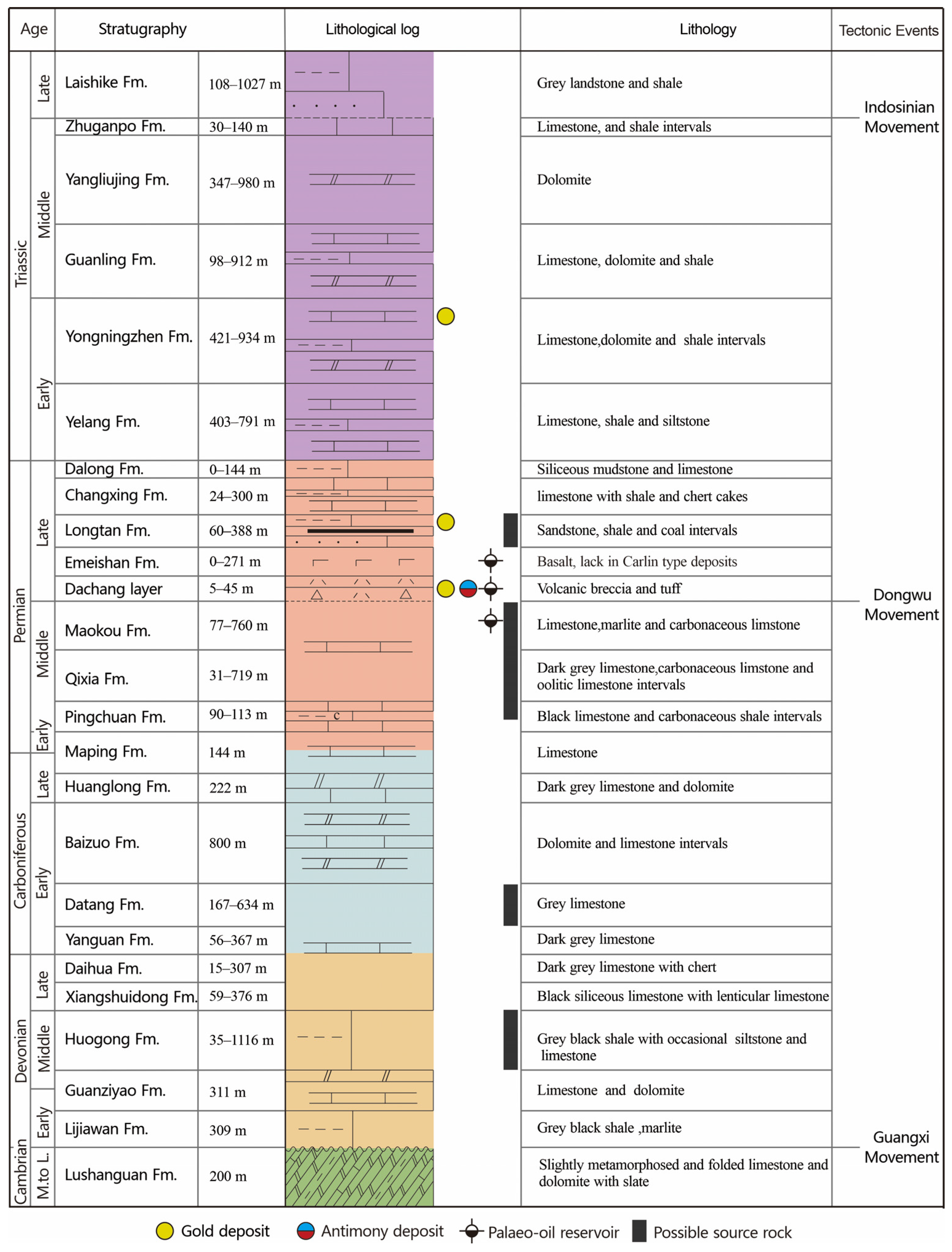

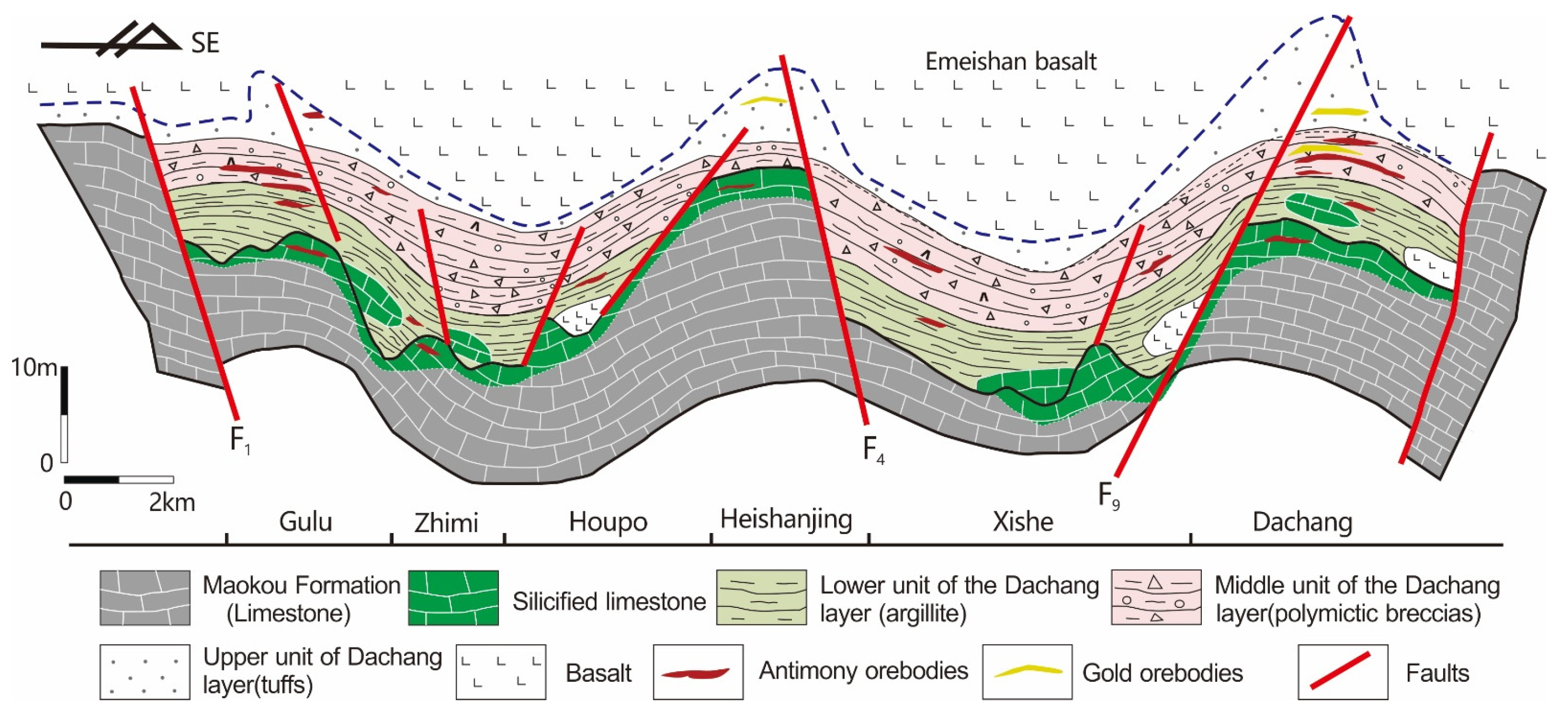

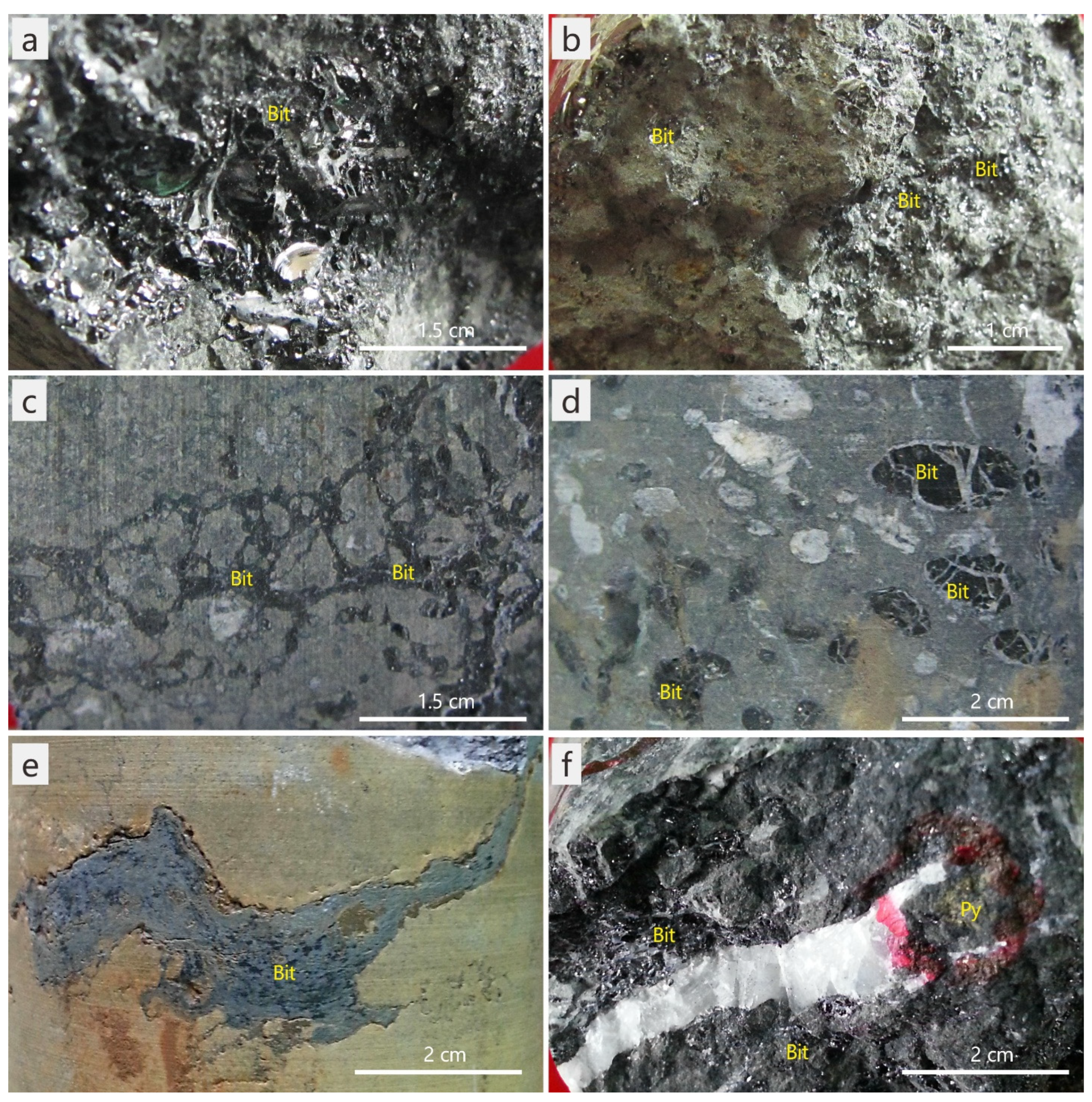
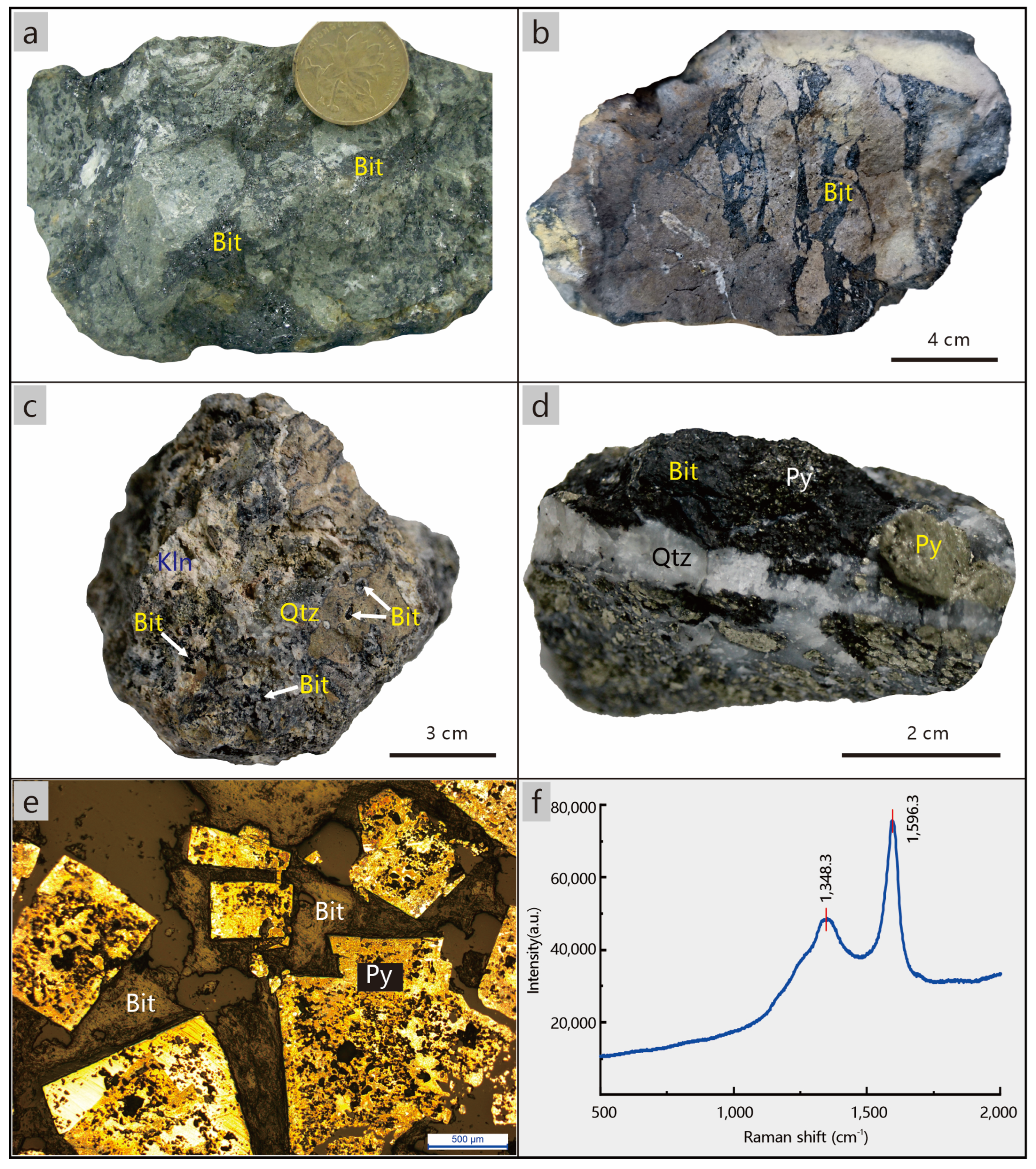
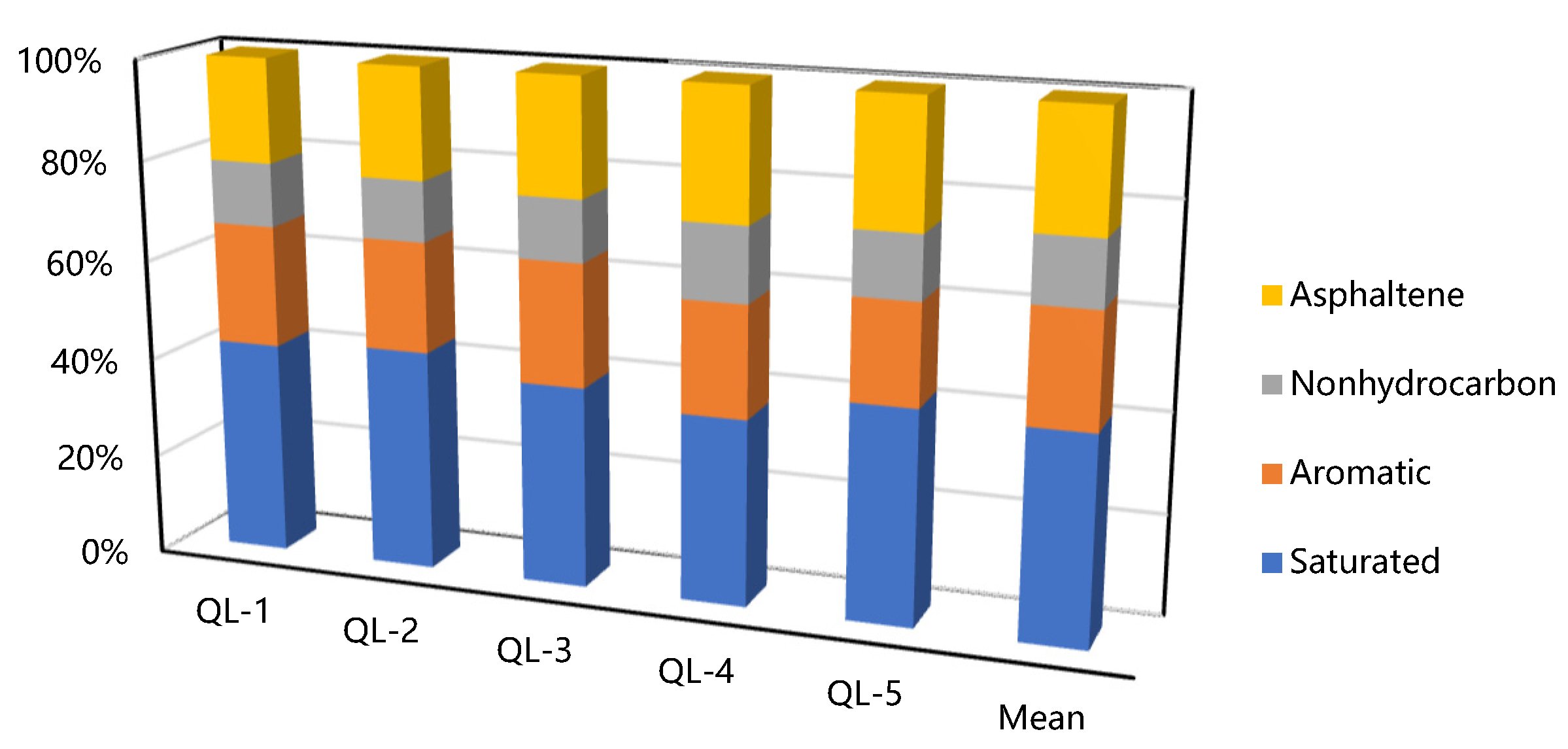
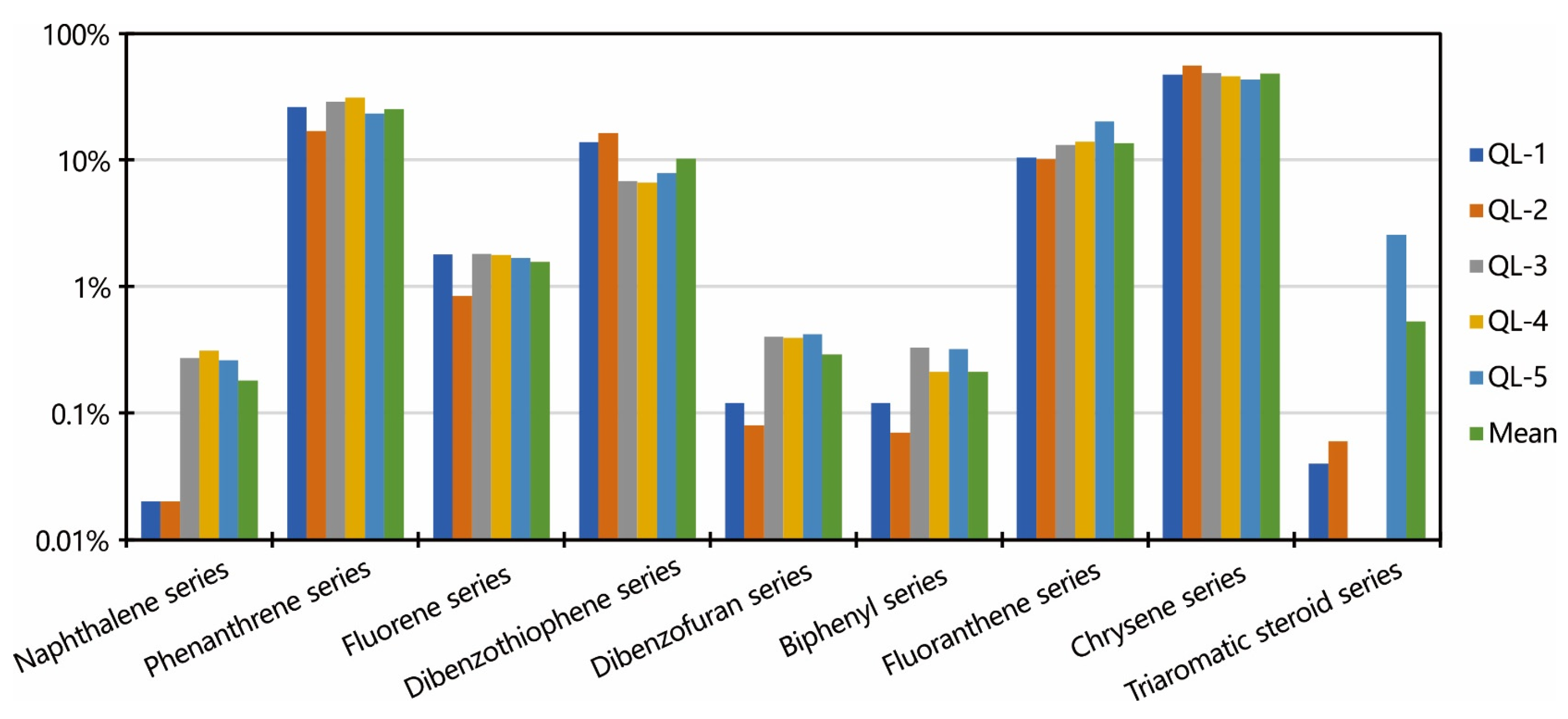
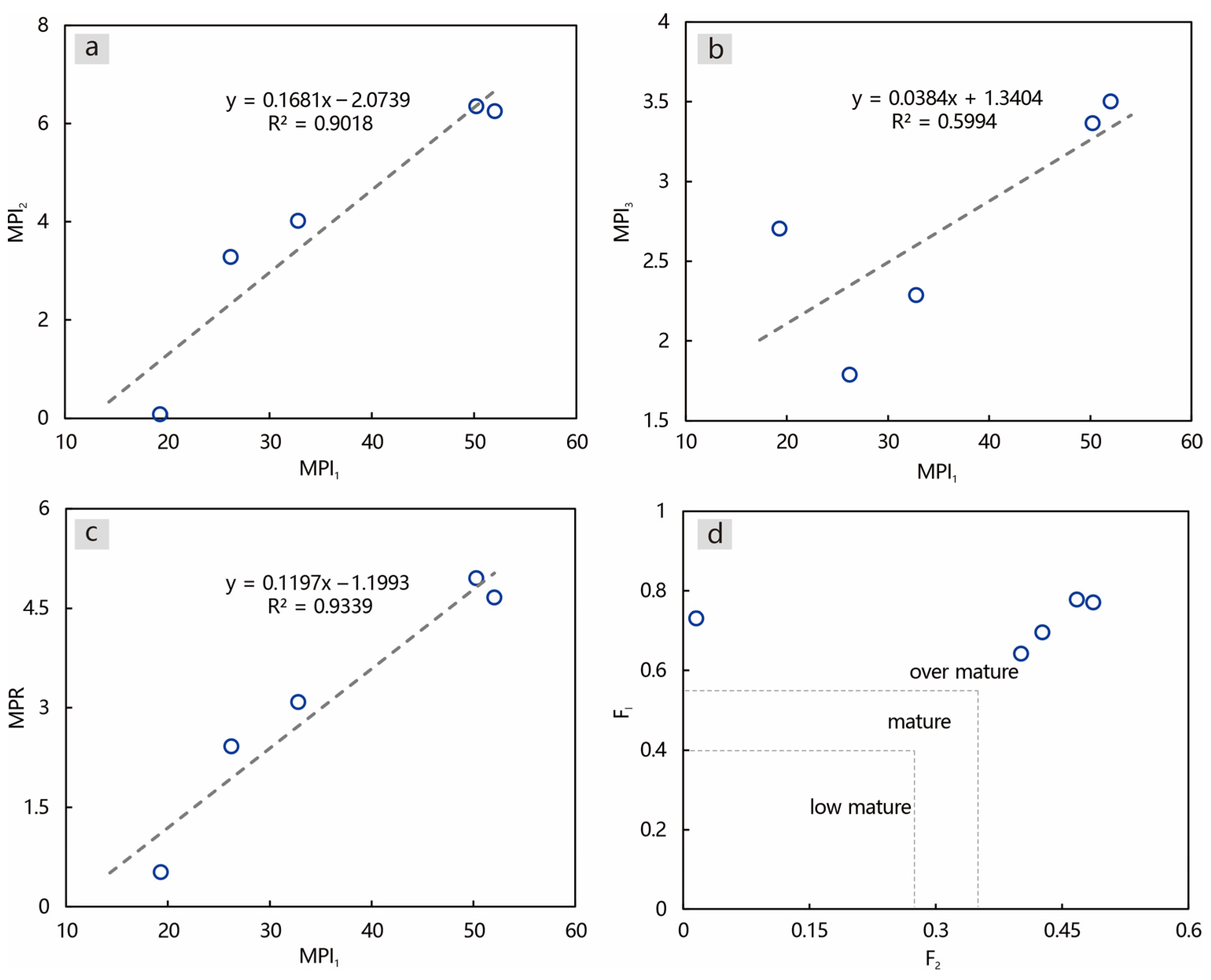
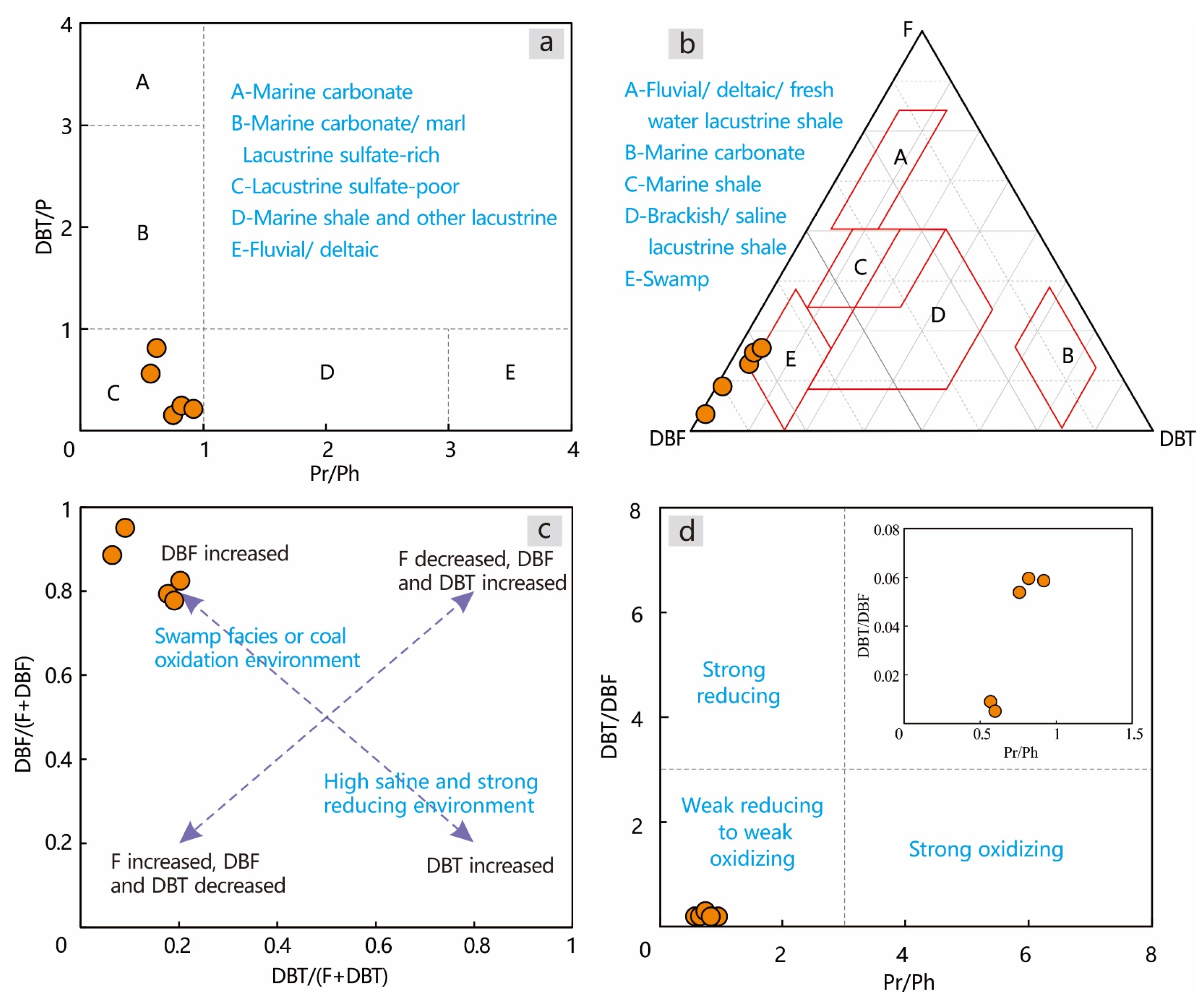

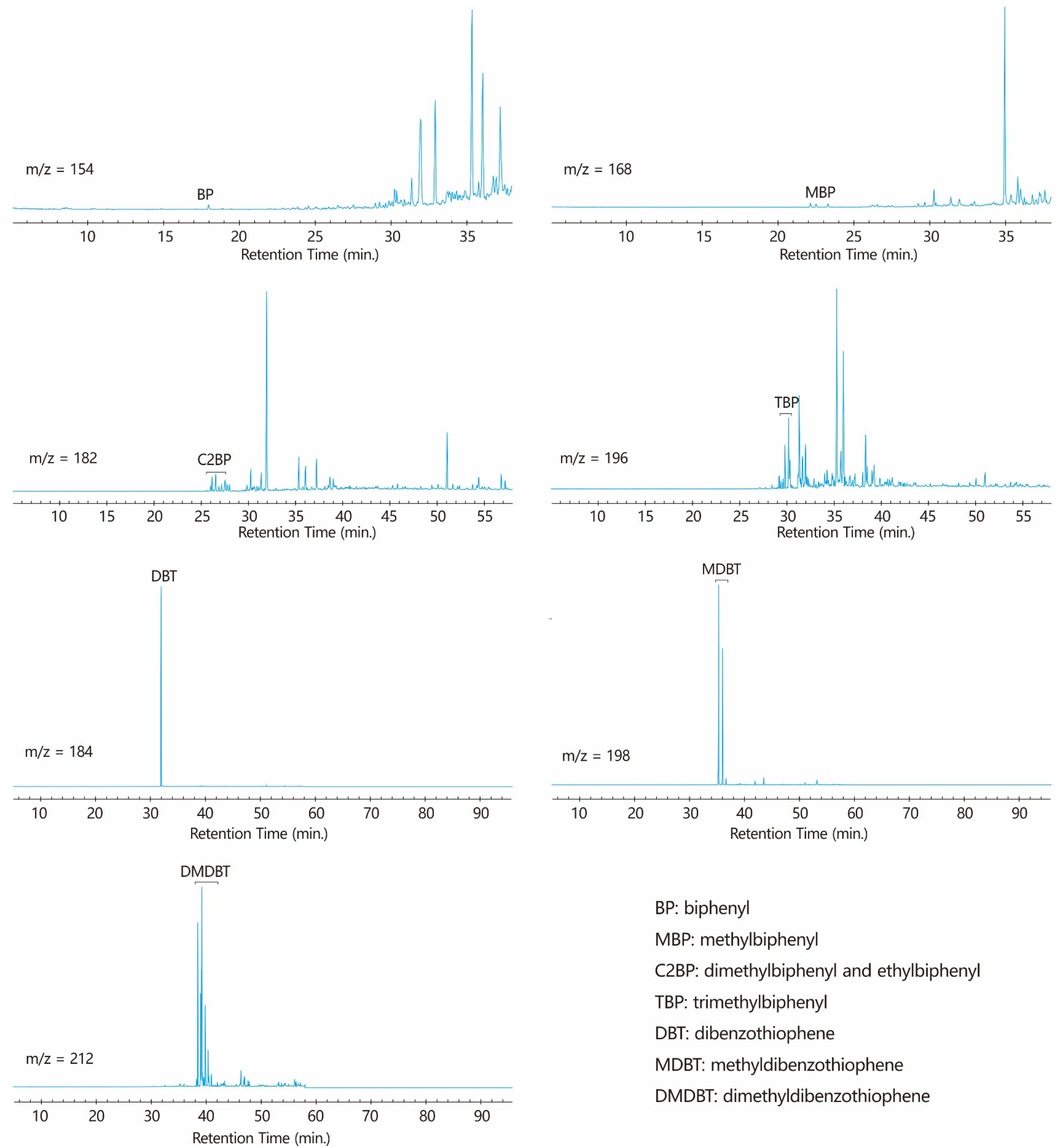
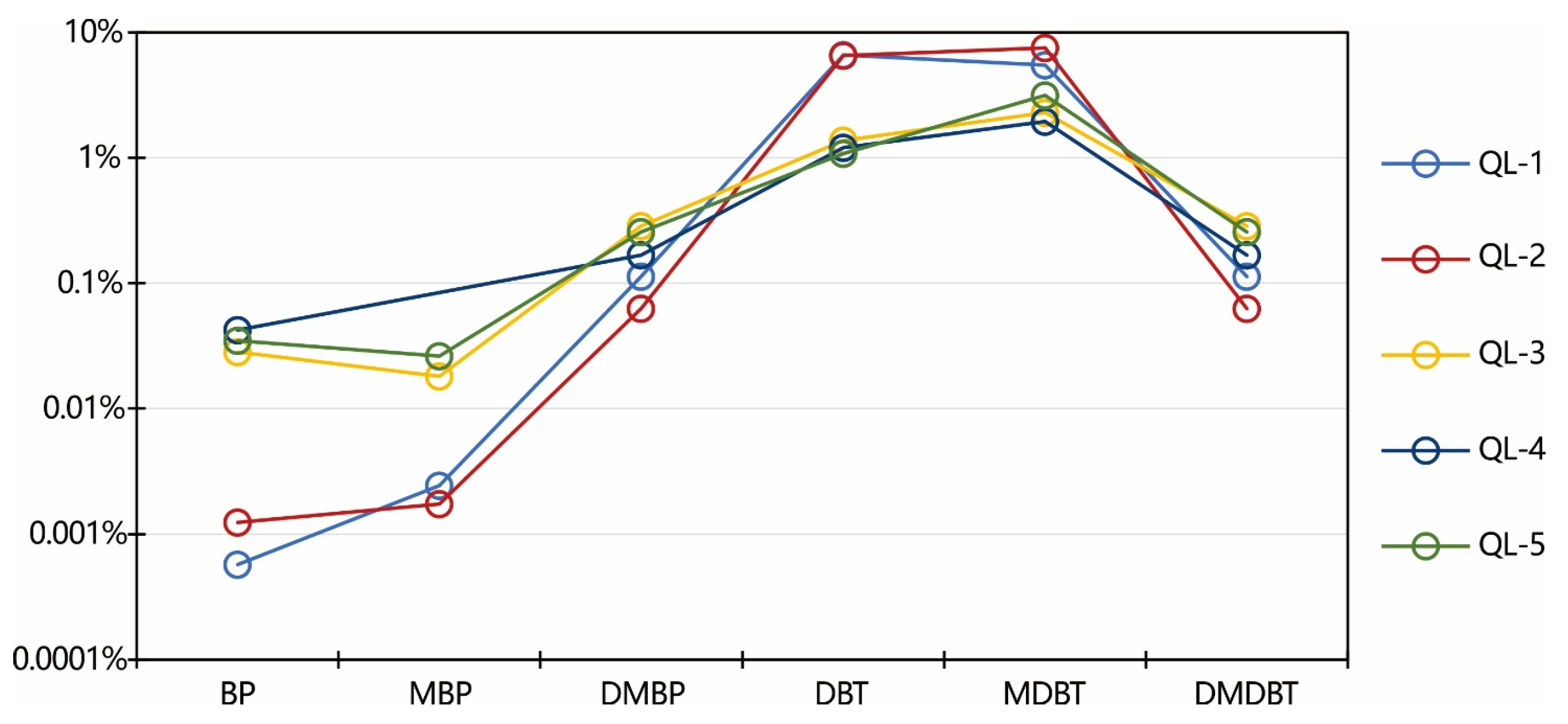
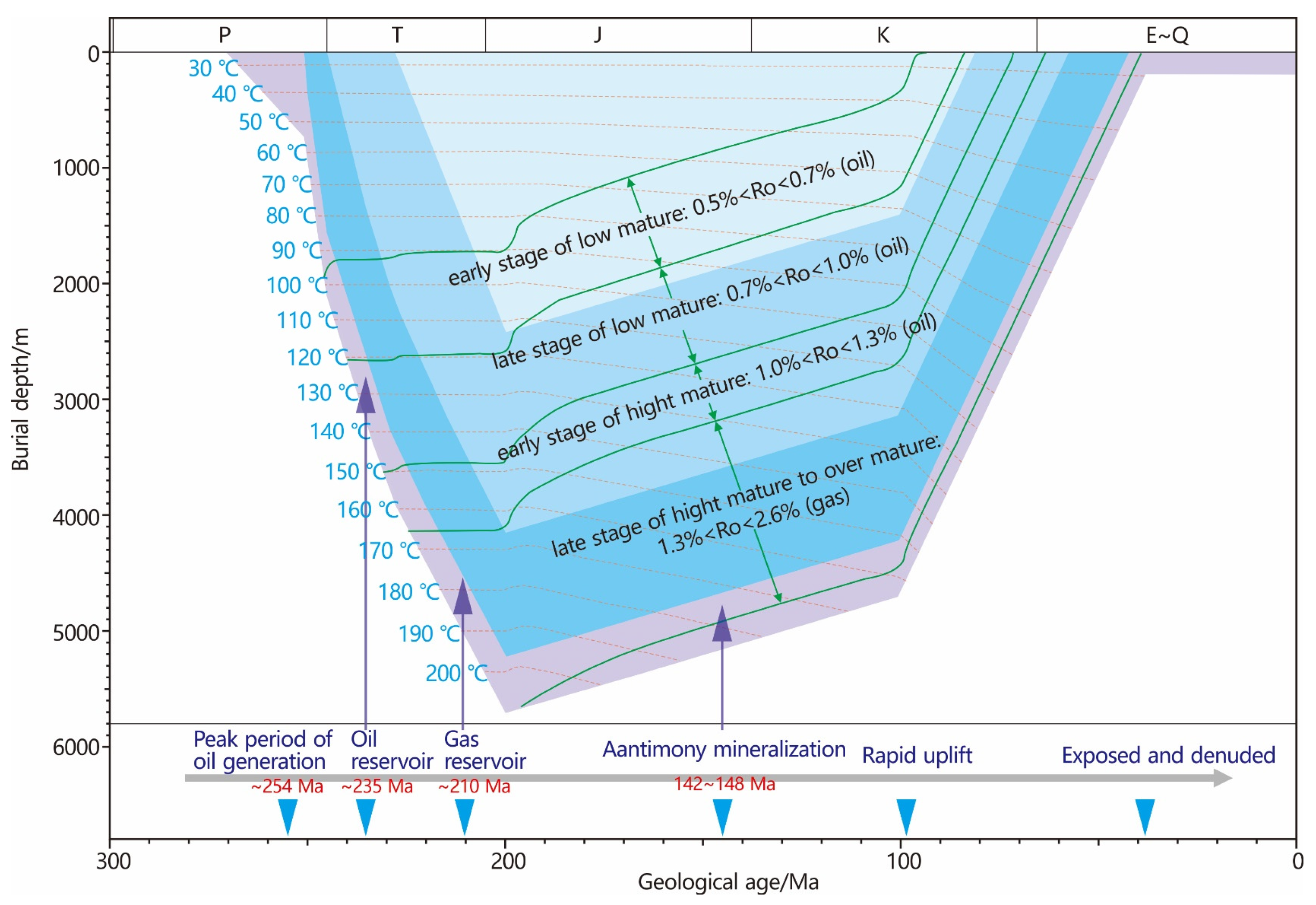
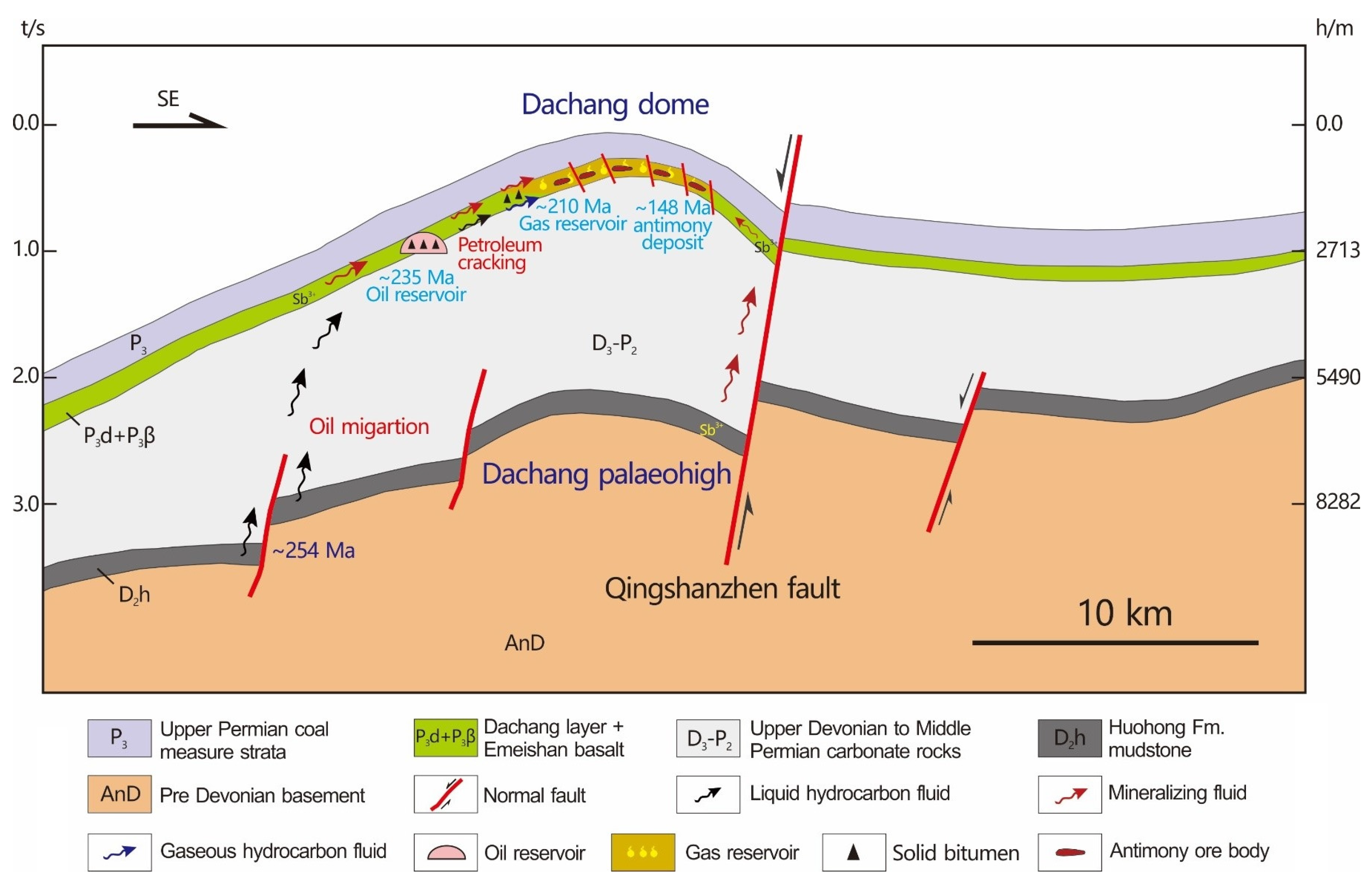
| Sample ID | QL-1 | QL-2 | QL-3 | QL-4 | QL-5 | Mean |
|---|---|---|---|---|---|---|
| DNR | 1.64 | 10.00 | 3.74 | - | - | 5.13 |
| Rc1 | 0.64 | 1.39 | 0.83 | - | - | 0.95 |
| TNR | 1.17 | 1.16 | - | - | - | 1.16 |
| Rc2 | 1.10 | 1.10 | - | - | - | 1.10 |
| TMNr | 0.67 | 0.66 | - | - | - | 0.66 |
| MPI1 | 52.04 | 50.26 | 32.81 | 26.22 | 19.30 | 36.13 |
| MPI2 | 6.25 | 6.35 | 4.02 | 3.28 | 0.08 | 4.00 |
| MPI3 | 3.50 | 3.36 | 2.29 | 1.79 | 2.70 | 2.73 |
| MPR | 4.66 | 4.95 | 3.08 | 2.42 | 0.52 | 3.12 |
| F1 | 0.78 | 0.77 | 0.70 | 0.64 | 0.73 | 0.72 |
| F2 | 0.47 | 0.49 | 0.43 | 0.40 | 0.02 | 0.36 |
| MDR | 26.23 | 24.14 | 14.45 | 11.69 | 15.48 | 18.40 |
| Rc3 | 1.11 | 0.77 | 17.16 | 29.54 | 17.49 | 13.21 |
| Rc4 | 1.21 | 0.46 | 1.88 | 40.72 | 22.11 | 13.28 |
| a | 0.60 | 0.61 | - | - | 0.67 | 0.63 |
| b | 0.08 | 1.09 | 0.67 | 0.48 | 0.82 | 0.63 |
| c | 0.99 | - | 181.03 | 138.47 | 473.36 | 198.46 |
| d | 1.03 | - | 184.64 | 141.57 | 481.68 | 202.23 |
| e | 0.08 | - | 121.71 | 67.13 | 385.88 | 143.70 |
| Rb | 2.10 | 2.40 | 2.43 | 2.46 | 2.51 | 2.38 |
Publisher’s Note: MDPI stays neutral with regard to jurisdictional claims in published maps and institutional affiliations. |
© 2022 by the authors. Licensee MDPI, Basel, Switzerland. This article is an open access article distributed under the terms and conditions of the Creative Commons Attribution (CC BY) license (https://creativecommons.org/licenses/by/4.0/).
Share and Cite
Cheng, Y.; Hu, Y.; Xu, S.; Wang, D. TSR Action and Genesis Mechanism of Antimony Deposit: Evidence from Aromatic Hydrocarbon Geochemistry of Bitumen from Paleo-Oil Reservoir in Qinglong Ore Field, Southwestern Guizhou Depression, China. Minerals 2022, 12, 1306. https://doi.org/10.3390/min12101306
Cheng Y, Hu Y, Xu S, Wang D. TSR Action and Genesis Mechanism of Antimony Deposit: Evidence from Aromatic Hydrocarbon Geochemistry of Bitumen from Paleo-Oil Reservoir in Qinglong Ore Field, Southwestern Guizhou Depression, China. Minerals. 2022; 12(10):1306. https://doi.org/10.3390/min12101306
Chicago/Turabian StyleCheng, Yong, Yuzhao Hu, Saihua Xu, and Di Wang. 2022. "TSR Action and Genesis Mechanism of Antimony Deposit: Evidence from Aromatic Hydrocarbon Geochemistry of Bitumen from Paleo-Oil Reservoir in Qinglong Ore Field, Southwestern Guizhou Depression, China" Minerals 12, no. 10: 1306. https://doi.org/10.3390/min12101306
APA StyleCheng, Y., Hu, Y., Xu, S., & Wang, D. (2022). TSR Action and Genesis Mechanism of Antimony Deposit: Evidence from Aromatic Hydrocarbon Geochemistry of Bitumen from Paleo-Oil Reservoir in Qinglong Ore Field, Southwestern Guizhou Depression, China. Minerals, 12(10), 1306. https://doi.org/10.3390/min12101306







